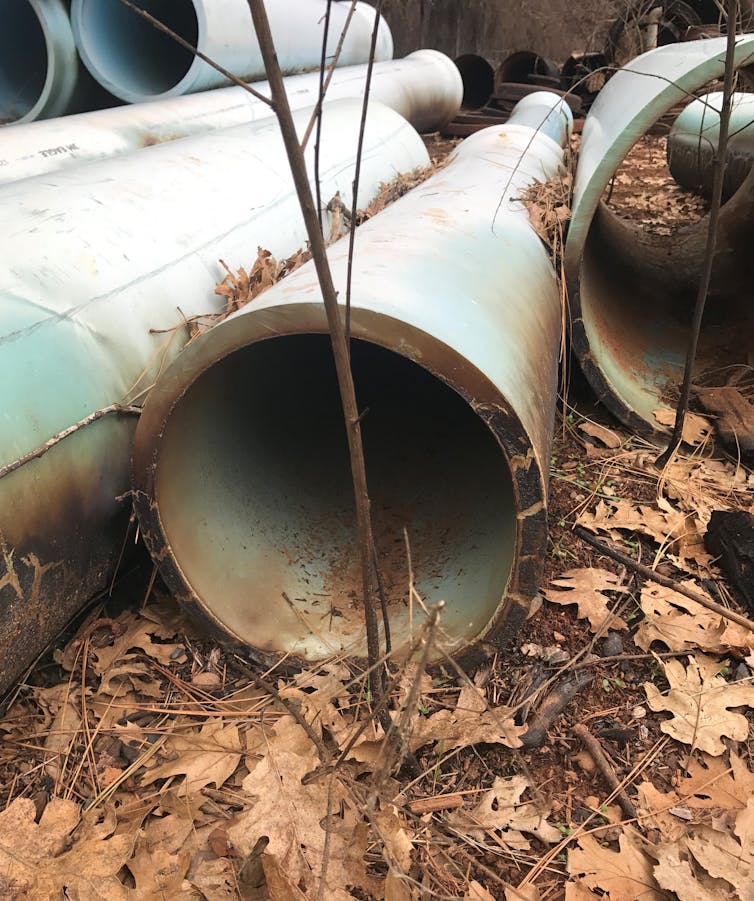Plastic pipes are polluting drinking water systems after wildfires – it’s a risk in urban fires, too

Andrew J. Whelton, Purdue University; Amisha Shah, Purdue University, and Kristofer P. Isaacson, Purdue University
When wildfires swept through the hills near Santa Cruz, California, in 2020, they released toxic chemicals into the water supplies of at least two communities. One sample found benzene, a carcinogen, at 40 times the state’s drinking water standard.
Our testing has now confirmed a source of these chemicals, and it’s clear that wildfires aren’t the only blazes that put drinking water systems at risk.
In a new study, we heated plastic water pipes commonly used in buildings and water systems to test how they would respond to nearby fires.
The results, released Dec. 14, show how easily wildfires could trigger widespread drinking water contamination. They also show the risks when only part of a building catches fire and the rest remains in use. In some of our tests, heat exposure caused more than 100 chemicals to leach from the damaged plastics.
As environmental engineers, we advise communities on drinking water safety and disaster recovery. The western U.S.’s extreme wildfire seasons are putting more communities at risk in ways they might not realize. Just this year, more than 52,000 fires destroyed more than 17,000 structures – many of them homes connected to water systems. Heat-damaged plastic pipes can continue to leach chemicals into water over time, and ridding a water system of the contamination can take months and millions of dollars.
A baffling source of contamination
The cause of drinking water contamination after wildfires has baffled authorities since it was discovered in 2017.
After the 2017 Tubbs Fire and 2018 Camp Fire, chemicals were found in buried water distribution networks, some at levels comparable to hazardous waste. Contamination was not in the water treatment plants or drinking water sources. Some homeowners found drinking water contamination in their plumbing.
Tests revealed volatile organic compounds had reached levels that posed immediate health risks in some areas, including benzene levels that exceeded the EPA hazardous waste threshold of 500 parts per billion. Benzene was found at a level 8,000 times the federal drinking water limit and 200 times the level that causes immediate health effects. Those effects can include dizziness, headaches, skin and throat irritation and even unconsciousness, among other risks.

This year, wildfires triggered drinking water contamination in at least two more California drinking water systems, and testing is still underway in other communities.
The problem with plastics
Plastics are ubiquitous in drinking water systems. They are often less expensive to install than metal alternatives, which hold up against high heat but are vulnerable to corrosion.
Today, water pipes under the street and those that deliver water to customers’ water meters are increasingly made of plastic. Pipes that transport the drinking water from the meter to the building are often plastic. Water meters also sometimes contain plastics. Private wells can have plastic well casings as well as buried plastic pipes that deliver well water to plastic storage tanks and buildings.
Pipes inside buildings that carry hot and cold water to faucets can also be plastic, as can faucet connectors, water heater dip tubes, refrigerator and ice maker tubing.

To determine if plastic pipes could be responsible for drinking water contamination after wildfires, we exposed commonly available plastic pipes to heat. The temperatures were similar to the heat from a wildfire that radiates toward buildings but isn’t enough to cause the pipes to catch fire.
We tested several popular plastic drinking water pipes, including high-density polyethylene (HDPE), crosslinked polyethylene (PEX), polyvinyl chloride (PVC) and chlorinated polyvinylchloride (CPVC).
Benzene and other chemicals were generated inside the plastic pipes just by heating. After the plastics cooled, these chemicals then leached into the water. It happened at temperatures as low as 392 degrees Fahrenheit. Fires can exceed 1,400 degrees.
While researchers previously discovered that plastics could release benzene and other chemicals into the air during heating, this new study shows heat-damaged plastics can directly leach dozens of toxic chemicals into water.
This article is republished from The Conversation. Read the full article here.
